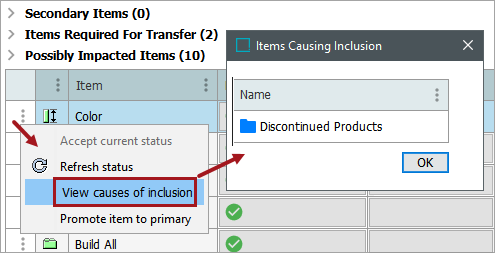When an item is added to a change package, the system tracks the status of the object from that point forward. If the selected object is changed, the change package notes a discrepancy between the version store in the change package and the current version in the system.
The Item column displays objects added to a change package and additional information is displayed in the following columns:
-
Before Install – the status of an object compared to the system. This column is displayed in all sections: Primary Items, Secondary Items, Items Required For Transfer, and Possibly Impacted Items.
-
Install Preview – the results are displayed after using the 'Start Impact Analysis' option which runs and rolls-back an install of the item on the system. When this column is blank, the Impact Analysis has never been run. This column is displayed only for the Primary Items and Secondary Items sections.
Note: Duplicating a change package or installing a change package resets the Install Preview column. Using the 'Refresh Status' option for an item or 'Refresh Status for all items' for the change package also resets the Install Preview column.
-
Current – the time elapsed since the item was included. This column is displayed for all sections.
-
Handling – the expected action as discussed in the Editing a Change Package topic. This column is displayed only for the Items Required For Transfer and Possibly Impacted Items sections.
-
Included – the date and time that the item was added to the change package. This column is displayed for all sections.
-
Instruction – text added automatically by the system or manually to assist in successfully installing the item. Double click the field to add instruction text manually. This column is displayed for all sections.

The status indicators displayed in the Before Install column as items are added to the change package. Indicators are updated in the Before Install column when the Refresh Status action is run either individually or as a whole.
The status indicators displayed in the Install Preview column are calculated and displayed after using the 'Start Impact Analysis' option. After the BGP has completed, the status indicators remain unchanged until the Impact Analysis runs again or the change package is duplicated or installed.
-
 is the new indicator and means the object does not exist in the system. In this case, the item was imported from a different system. This icon is only displayed in the Before Install column.
is the new indicator and means the object does not exist in the system. In this case, the item was imported from a different system. This icon is only displayed in the Before Install column. -
 is the synchronized indicator and means the object reflected the current status when it was last compared to the system or that installing it will keep it synchronized. This icon can be displayed in the Before Install column and the Install Preview column.
is the synchronized indicator and means the object reflected the current status when it was last compared to the system or that installing it will keep it synchronized. This icon can be displayed in the Before Install column and the Install Preview column. -
 is the difference indicator and means that the object has changed since it was added to the package or that installing it will result in a different object. This icon can be displayed in the Before Install column and the Install Preview column.
is the difference indicator and means that the object has changed since it was added to the package or that installing it will result in a different object. This icon can be displayed in the Before Install column and the Install Preview column. -
 is the 'not imported' indicator and means that, based on Impact Analysis, the object cannot be imported automatically; manual actions are required. This icon is only displayed in the Install Preview column.
is the 'not imported' indicator and means that, based on Impact Analysis, the object cannot be imported automatically; manual actions are required. This icon is only displayed in the Install Preview column. -
 is the 'manually accepted' indicator and means that the 'Accept current status' option was used.
is the 'manually accepted' indicator and means that the 'Accept current status' option was used.
The background color of the Item column indicates the level of support for importing the object. Each color is described and identified by the numbers in the following image. Hover over an object to display a link to the object and the help text for the object, as shown for the DC Key object in the image.
-
Item 1 – the light gray background indicates an object that is fully supported for analysis and installation
-
Item 2 – the yellow background indicates that full support is not available for installing the object on the target system. Manual actions are defined in the hover text and are added to the Instruction field.
-
Item 3 – the orange background indicates that the objects need to be verified manually. These are objects that cannot have their contents analyzed or referenced objects identified. For example, a Web UI, Asset Importer, or IEP, is not parsed to identify any related business rules or workflows. Also, because they are not included in the Items Required for Transfer, and are not reported on the impact analysis, they require manual operations before and/or after installation. Since many of these objects are installed correctly when all associated objects are included manually, they should be verified to ensure the intended functionality and if not, the change package must be revised in the source system.
-
Item 4 – the light-yellow background indicates that the object is part of the system’s base configuration and cannot be moved from one system to another via a change package.
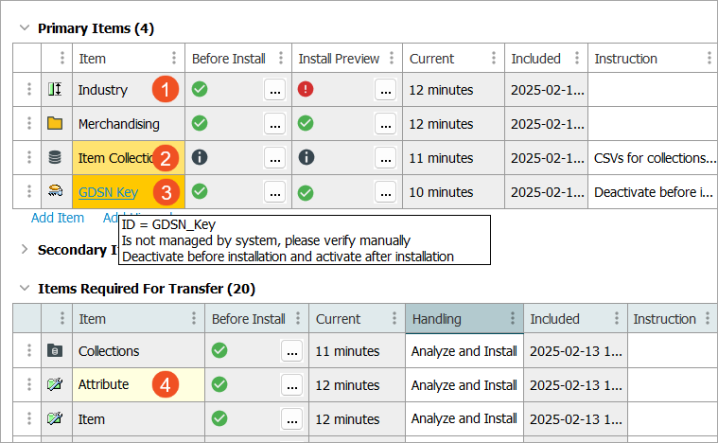
Considerations for Sealed Change Packages
Since at the time of sealing, the change package retrieves the current system version of all objects included in the change package, all objects have a synchronized indicator ( ) upon sealing.
) upon sealing.
-
Following sealing, objects can be refreshed and if a subsequent discrepancy arises, the object has a 'difference' indicator (
 ).
). -
Exporting a change package includes all objects as they were at the time the package was sealed. The option to 'Accept current status' is not available while the package is sealed.
-
Workspace-revisable objects must be current with their approvals and show a synchronized indicator (
 ) prior to sealing the change package.
) prior to sealing the change package. -
When workspace-revisable objects are installed on a target system, they must be approved for the Before Install status to show a synchronized indicator (
 ).
).
Refresh Status
Refreshing the status sets the Current column to '0 minutes' and updates the indicators on the object and can be used for change packages that are not dormant.
To check the status of items in the change package, click on the row arrow in the item(s) and select Refresh Status or after a change package has been installed, right-click the change package and use the Refresh Status of All Items option to confirm the installation. For example, when installing a product node to support newly added attributes, the product requires approval to display a synchronized indicator ( ) after the status is refreshed.
) after the status is refreshed.
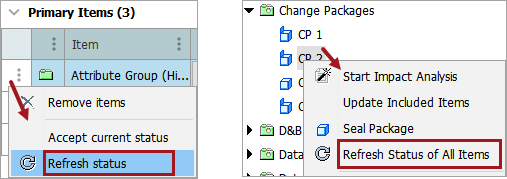
The refresh option is available on all change package objects, regardless of their current status or the status of the change package.
Compare Package Contents with Current
For a detailed comparison of a change package object against the current system, click the Before Install column of an item to display the Compare Package Contents dialog.
Differences are displayed with the Change Package contents in the 'Package Contents' panel (on the left) and the current system contents in the 'Current' panel.
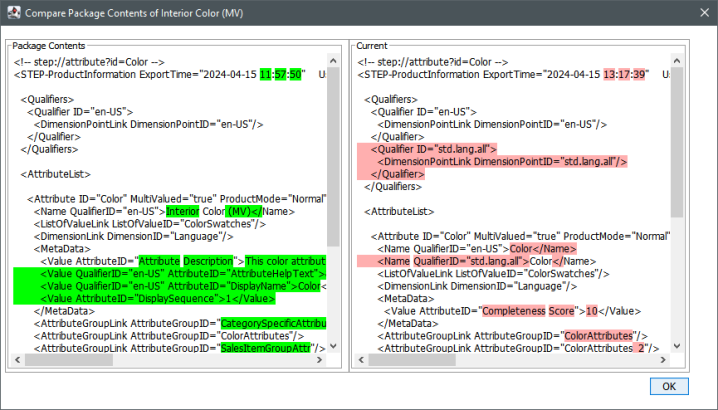
Note: When a change package is imported to a target system but has not been installed, the 'Current' panel shows no content.
For large STEPXML files, like a Web UI, the comparison may become excessive, causing the comparison to be skipped. If this happens, the text is highlighted yellow (as shown below). Similarly, avoid assets with large binary contents in change packages as the comparisons may not be possible.
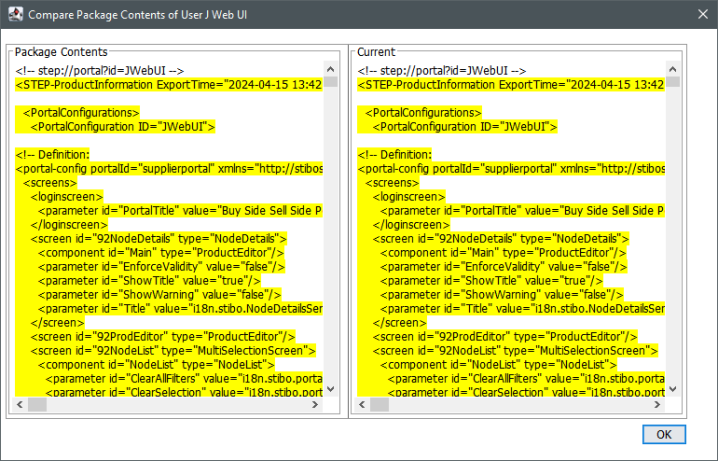
Accept Current Status
If an object has changed since being added to the package, it has a difference indicator ( ) and the Accept Current Status action is available on the row's right-click menu.
) and the Accept Current Status action is available on the row's right-click menu.
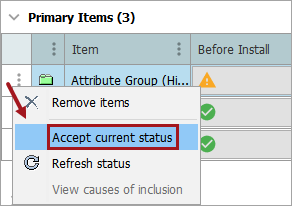
Accepting the current status of an item adds the 'Accept current status' indicator ( ). This means that the object has changed since its addition to the package, but that the change has been verified and the current object is accepted as part of the package.
). This means that the object has changed since its addition to the package, but that the change has been verified and the current object is accepted as part of the package.
Note: This option is only available for objects that are not up to date and are part of an open change package. If the package has been sealed this option is not available, regardless of object status.
View Causes of Inclusion
The 'View causes for inclusion' option is available for single or multi- selected items for the following sections:
-
Secondary Items
-
Items Required for Transfer
-
Possibly Impacted Items
